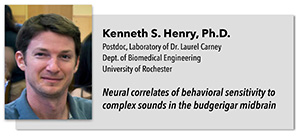Post-doc / Faculty Seminar Series
Date: January 14, 2016
Location: K-307 (3-6408), University of Rochester Medical Center

Neural correlates of behavioral sensitivity to complex sounds in the budgerigar midbrain
Kenneth Henry, Ph.D.
Postdoc, Carney Lab
Department of Biomedical Engineering
University of Rochester
Amplitude modulation (AM) is a critically important acoustic feature of many complex communication signals including human speech. The peripheral auditory system encodes AM through neural envelope synchrony, i.e., temporal fluctuations in instantaneous discharge rate at the modulation frequency of the stimulus. Neurons of the auditory midbrain encode AM through both envelope synchrony and, moreover, variation in average discharge rate with AM depth (rate coding of AM). Here, we discuss our recent studies of behavioral and neural (midbrain) sensitivity to AM in the budgerigar, an avian vocal learner with the capacity to mimic human speech. Neurophysiological recordings in awake, passively listening budgerigars show that thresholds based on average discharge rate (minimum detectable modulation depth) are insufficient to explain human-like behavioral sensitivity to AM in this species. Thresholds based on envelope synchrony, in contrast, can explain behavioral AM sensitivity to tone- and noise-carrier stimuli across a broad range of modulation frequencies. These results suggest that envelope synchrony in the midbrain plays a key role in AM perception. Ongoing neurophysiological recordings in budgerigars engaged in an AM detection task provide additional insight into the neural mechanisms (average rate vs. envelope synchrony) underlying human-like behavioral sensitivity to AM.
Refreshments will be provided
Sponsored by the Rochester Chapter of the Society for Neuroscience
Stay Up-To-Date
Subscribe to the SFN Rochester Chapter LISTSERV to receive news and events via email.
